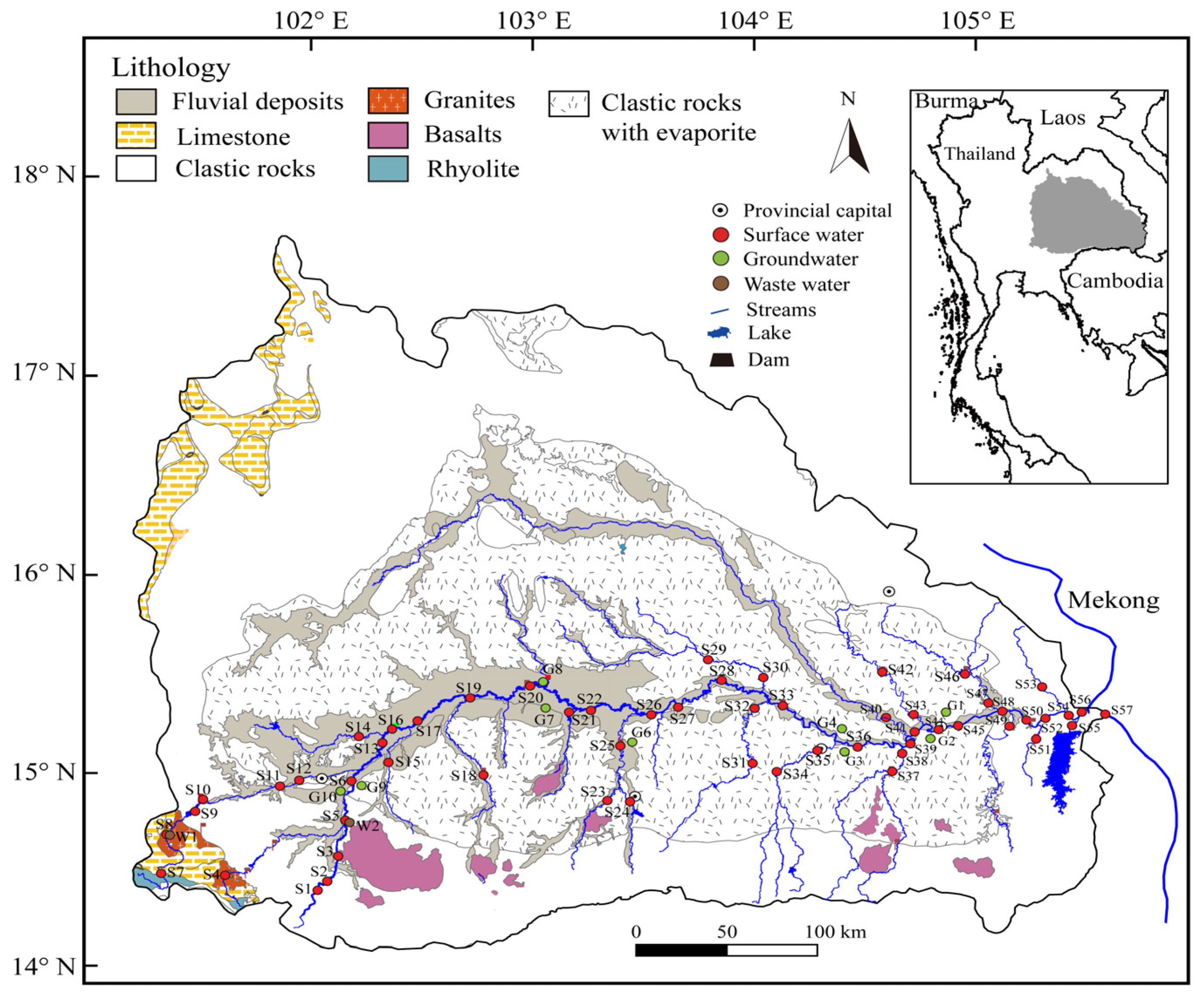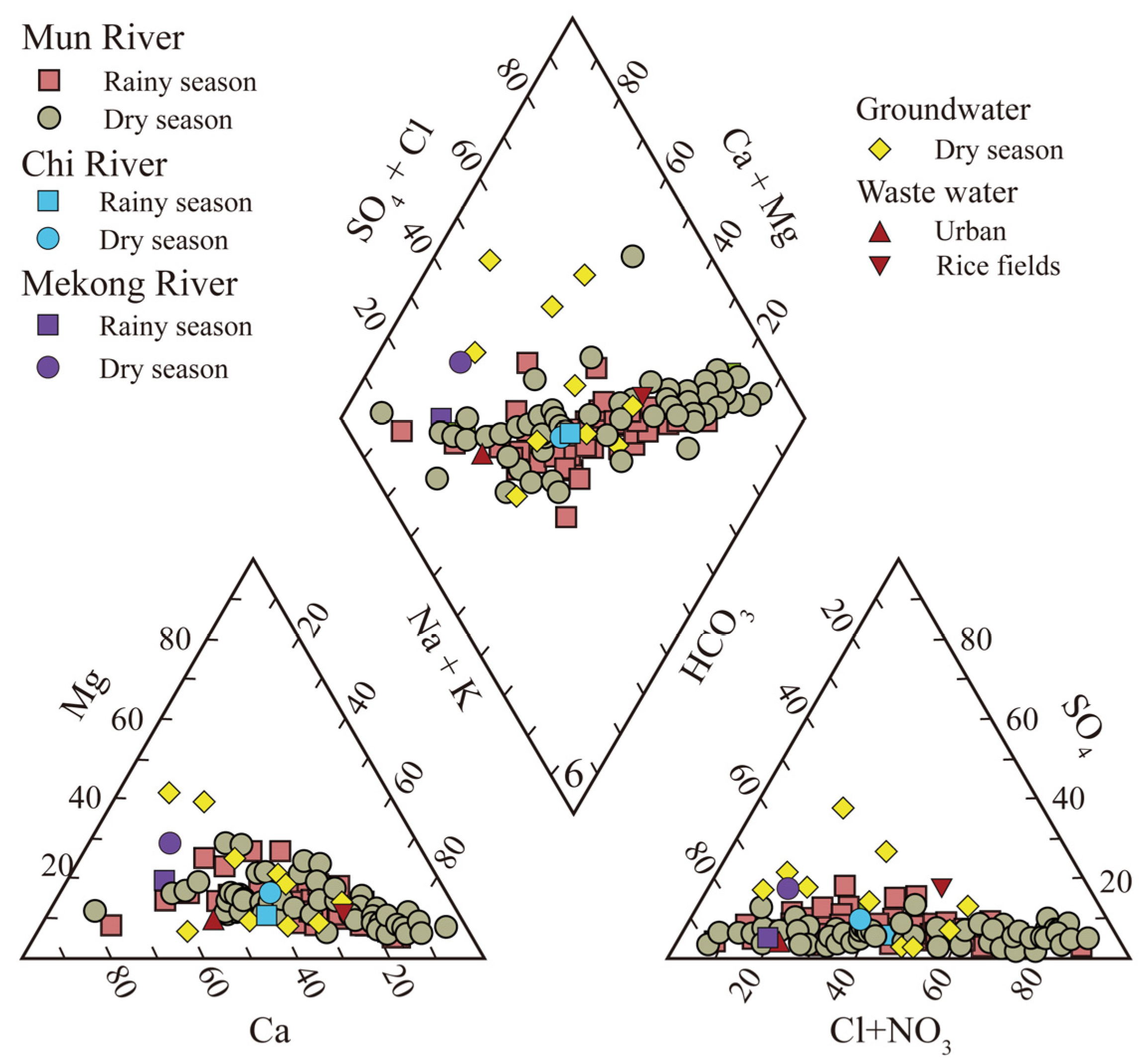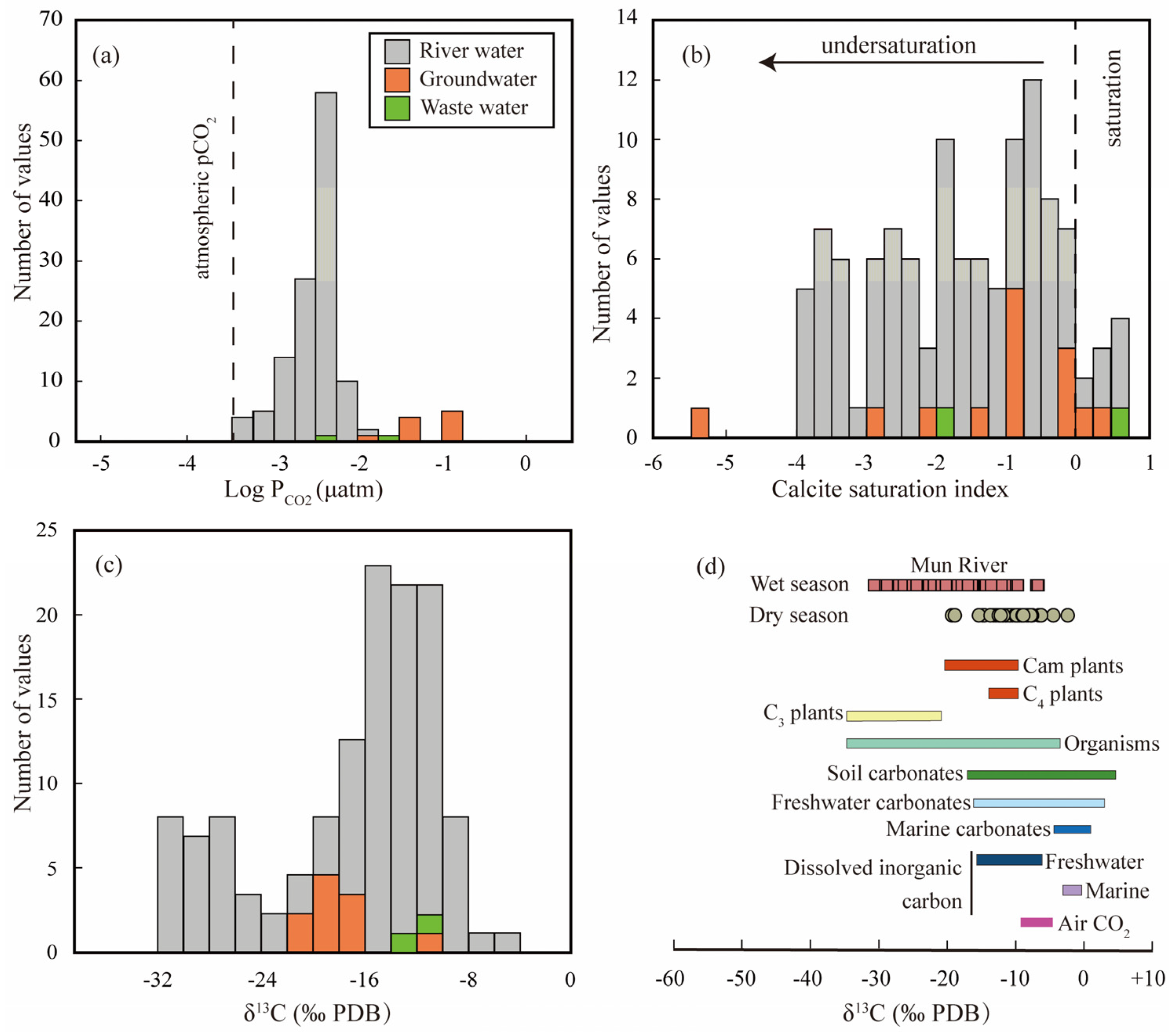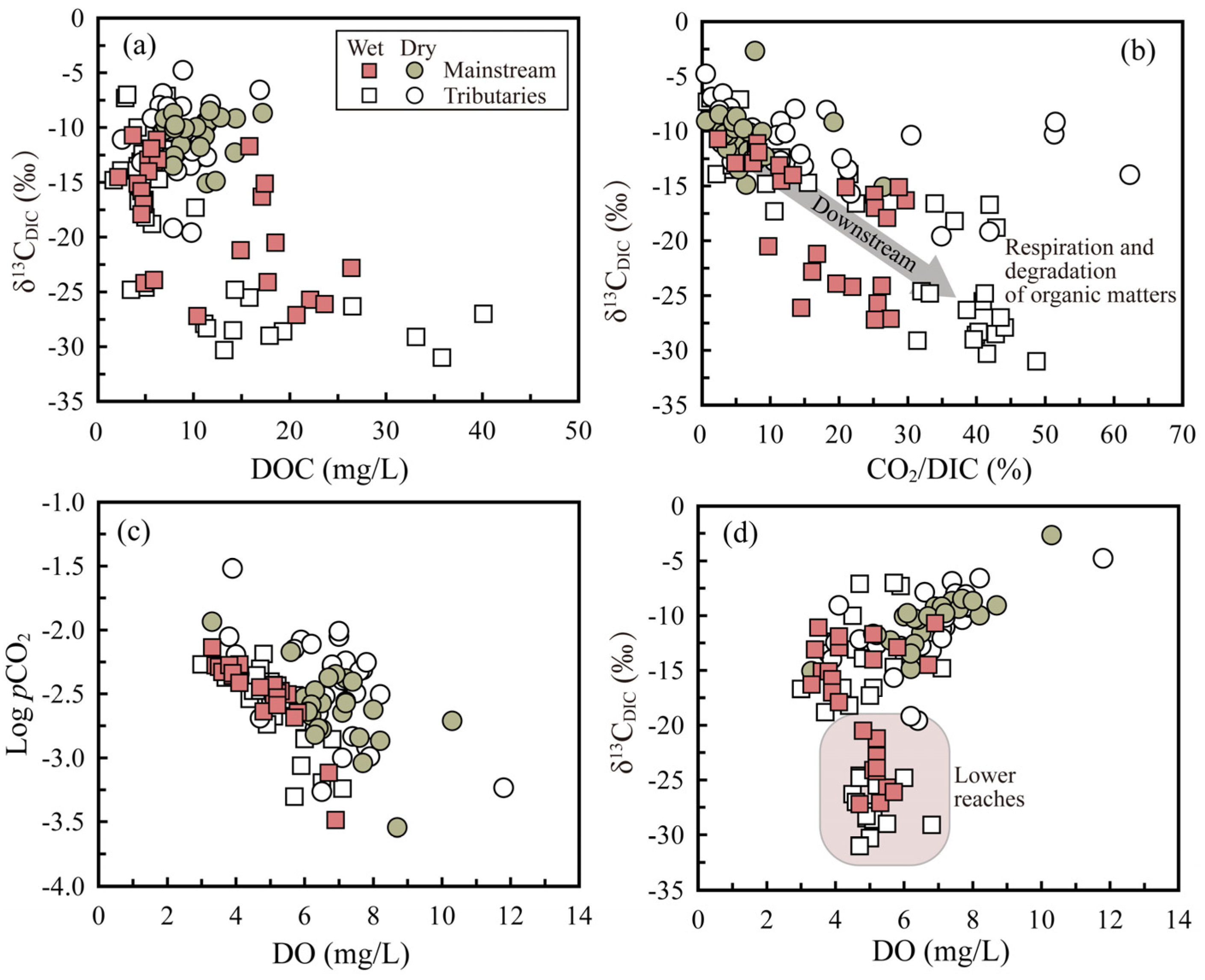Seasonal and Spatial Variations of δ13CDIC Values in the Mun River, Northeast Thailand
Abstract
:1. Introduction
2. Material and Methods
2.1. Mun River Watershed
2.2. Sampling and Analysis
2.3. Statistical and Spatial Analysis
3. Results and Discussion
3.1. General Characteristics of Water Chemistry
3.2. DIC and δ13CDIC in River Water
4. Discussion
4.1. Seasonal and Spatial Variations of DIC and δ13CDIC
4.2. Chemical Weathering and the δ13CDIC in River Water
4.3. δ13 CDIC Decline Induced by Biologic Causes
4.4. CO2 Outgassing and Equilibrium Exchange Processes
5. Conclusions
Supplementary Materials
Author Contributions
Funding
Institutional Review Board Statement
Informed Consent Statement
Data Availability Statement
Acknowledgments
Conflicts of Interest
References
- Hilton, R.G.; West, A.J. Mountains, erosion and the carbon cycle. Nat. Rev. Earth Environ. 2020, 1, 284–299. [Google Scholar] [CrossRef]
- Maher, K.; Chamberlain, C.P. Hydrologic Regulation of Chemical Weathering and the Geologic Carbon Cycle. Science 2014, 343, 1502. [Google Scholar] [CrossRef] [PubMed]
- Liu, J.; Han, G. Tracing Riverine Particulate Black Carbon Sources in Xijiang River Basin: Insight from Stable Isotopic Composition and Bayesian Mixing Model. Water Res. 2021, 194, 116932. [Google Scholar] [CrossRef] [PubMed]
- Berner, R.A.; Caldeira, K. The need for mass balance and feedback in the geochemical carbon cycle. Geology 1998, 25, 955–966. [Google Scholar] [CrossRef]
- Goudie, A.S.; Viles, H.A. Weathering and the global carbon cycle: Geomorphological perspectives. Earth-Sci. Rev. 2012, 113, 59–71. [Google Scholar] [CrossRef]
- Han, G.; Tang, Y.; Liu, M.; Van Zwieten, L.; Yang, X.; Yu, C.; Wang, H.; Song, Z. Carbon-nitrogen isotope coupling of soil organic matter in a karst region under land use change, Southwest China. Agric. Ecosyst. Environ. 2020, 301, 107027. [Google Scholar] [CrossRef]
- Liu, M.; Han, G.L.; Zhang, Q. Effects of agricultural abandonment on soil aggregation, soil organic carbon storage and stabilization: Results from observation in a small karst catchment, Southwest China. Agric. Ecosyst. Environ. 2020, 288, 106719. [Google Scholar] [CrossRef]
- Li, X.; Han, G.; Zhang, Q.; Qu, R.; Miao, Z. Accurate lithium isotopic analysis of twenty geological reference materials by multi-collector inductively coupled plasma mass spectrometry. Spectrochim. Acta Part B At. Spectrosc. 2022, 188, 106348. [Google Scholar] [CrossRef]
- Zeng, J.; Han, G. Tracing zinc sources with Zn isotope of fluvial suspended particulate matter in Zhujiang River, Southwest China. Ecol. Indic. 2020, 118, 106723. [Google Scholar] [CrossRef]
- Zeng, J.; Han, G. Preliminary copper isotope study on particulate matter in Zhujiang River, southwest China: Application for source identification. Ecotoxicol. Environ. Saf. 2020, 196, 110663. [Google Scholar] [CrossRef]
- Han, G.; Zeng, J. Iron isotope of suspended particulate matter in Zhujiang River, Southwest China: Characteristics, sources, and environmental implications. Sci. Total Environ. 2021, 793, 148562. [Google Scholar] [CrossRef] [PubMed]
- Tipper, E.T.; Stevenson, E.I.; Alcock, V.; Knight, A.C.G.; Baronas, J.J.; Hilton, R.G.; Bickle, M.J.; Larkin, C.S.; Feng, L.; Relph, K.E.; et al. Global silicate weathering flux overestimated because of sediment-water cation exchange. Proc. Natl. Acad. Sci. USA 2021, 118, e2016430118. [Google Scholar] [CrossRef] [PubMed]
- Torres, M.A.; West, A.J.; Clark, K.E.; Paris, G.; Bouchez, J.; Ponton, C.; Feakins, S.J.; Galy, V.; Adkins, J.F. The acid and alkalinity budgets of weathering in the Andes–Amazon system: Insights into the erosional control of global biogeochemical cycles. Earth Planet. Sci. Lett. 2016, 450, 381–391. [Google Scholar] [CrossRef] [Green Version]
- Moquet, J.-S.; Crave, A.; Viers, J.; Seyler, P.; Armijos, E.; Bourrel, L.; Chavarri, E.; Lagane, C.; Laraque, A.; Casimiro, W.S.L.; et al. Chemical weathering and atmospheric/soil CO2 uptake in the Andean and Foreland Amazon basins. Chem. Geol. 2011, 287, 1–26. [Google Scholar] [CrossRef]
- Chetelat, B.; Liu, C.Q.; Zhao, Z.Q.; Wang, Q.L.; Li, S.L.; Li, J.; Wang, B.L. Geochemistry of the dissolved load of the Changjiang Basin rivers: Anthropogenic impacts and chemical weathering. Geochim. Cosmochim. Acta 2008, 72, 4254–4277. [Google Scholar] [CrossRef]
- Wu, W.; Yang, J.; Xu, S.; Yin, H. Geochemistry of the headwaters of the Yangtze River, Tongtian He and Jinsha Jiang: Silicate weathering and CO2 consumption. Appl. Geochem. 2008, 23, 3712–3727. [Google Scholar] [CrossRef]
- Gaillardet, J.; Dupre, B.; Louvat, P.; Allegre, C.J. Global silicate weathering and CO2 consumption rates deduced from the chemistry of large rivers. Chem. Geol. 1999, 159, 3–30. [Google Scholar] [CrossRef]
- Zeghioud, H.; Assadi, A.A.; Khellaf, N.; Djelal, H.; Amrane, A.; Rtimi, S. Photocatalytic Performance of CuxO/TiO(2) Deposited by HiPIMS on Polyester under Visible Light LEDs: Oxidants, Ions Effect, and Reactive Oxygen Species Investigation. Materials 2019, 12, 412. [Google Scholar] [CrossRef] [Green Version]
- Baaloudj, O.; Assadi, I.; Nasrallah, N.; El Jery, A.; Khezami, L.; Assadi, A.A. Simultaneous removal of antibiotics and inactivation of antibiotic-resistant bacteria by photocatalysis: A review. J. Water Process Eng. 2021, 42, 102089. [Google Scholar] [CrossRef]
- Wang, T.; Wang, L.; Chen, Q.; Kalogerakis, N.; Ji, R.; Ma, Y. Interactions between microplastics and organic pollutants: Effects on toxicity, bioaccumulation, degradation, and transport. Sci. Total Environ. 2020, 748, 142427. [Google Scholar] [CrossRef]
- Zeng, J.; Han, G.; Zhang, S.; Liang, B.; Qu, R.; Liu, M.; Liu, J. Potentially toxic elements in cascade dams-influenced river originated from Tibetan Plateau. Environ. Res. 2022, 208, 112716. [Google Scholar] [CrossRef] [PubMed]
- Marx, A.; Dusek, J.; Jankovec, J.; Sanda, M.; Vogel, T.; van Geldern, R.; Hartmann, J.; Barth, J.A.C. A review of CO2 and associated carbon dynamics in headwater streams: A global perspective. Rev. Geophys. 2017, 55, 560–585. [Google Scholar] [CrossRef]
- Meybeck, M. Global chemical-weathering of surfical rocks estimated from river dissolved loads. Am. J. Sci. 1987, 287, 401–428. [Google Scholar] [CrossRef]
- Suchet, P.A.; Probst, J.L.; Ludwig, W. Worldwide distribution of continental rock lithology: Implications for the atmospheric/soil CO2 uptake by continental weathering and alkalinity river transport to the oceans. Glob. Biogeochem. Cycles 2003, 17, 1038. [Google Scholar] [CrossRef] [Green Version]
- Clark, I.; Fritz, P. Environmental Isotopes in Hydrogeology; CRC Press: New York, NY, USA, 1997. [Google Scholar] [CrossRef]
- Cartwright, I. The origins and behaviour of carbon in a major semi-arid river, the Murray River, Australia, as constrained by carbon isotopes and hydrochemistry. Appl. Geochem. 2010, 25, 1734–1745. [Google Scholar] [CrossRef]
- Li, S.-L.; Liu, C.-Q.; Li, J.; Lang, Y.-C.; Ding, H.; Li, L. Geochemistry of dissolved inorganic carbon and carbonate weathering in a small typical karstic catchment of Southwest China: Isotopic and chemical constraints. Chem. Geol. 2010, 277, 301–309. [Google Scholar] [CrossRef]
- Aucour, A.M.; Sheppard, S.M.F.; Guyomar, O.; Wattelet, J. Use of 13C to trace origin and cycling of inorganic carbon in the Rhone river system. Chem. Geol. 1999, 159, 87–105. [Google Scholar] [CrossRef]
- Barth, J.A.C.; Cronin, A.A.; Dunlop, J.; Kalin, R.M. Influence of carbonates on the riverine carbon cycle in an anthropogenically dominated catchment basin: Evidence from major elements and stable carbon isotopes in the Lagan River (N. Ireland). Chem. Geol. 2003, 200, 203–216. [Google Scholar] [CrossRef]
- Wachniew, P. Isotopic composition of dissolved inorganic carbon in a large polluted river: The Vistula, Poland. Chem. Geol. 2006, 233, 293–308. [Google Scholar] [CrossRef]
- Liu, J.; Han, G. Controlling factors of riverine CO2 partial pressure and CO2 outgassing in a large karst river under base flow condition. J. Hydrol. 2021, 593, 125638. [Google Scholar] [CrossRef]
- Liu, J.; Han, G. Controlling factors of seasonal and spatial variation of riverine CO2 partial pressure and its implication for riverine carbon flux. Sci. Total Environ. 2021, 786, 147332. [Google Scholar] [CrossRef] [PubMed]
- Qin, C.Q.; Li, S.L.; Waldron, S.; Yue, F.J.; Wang, Z.J.; Zhong, J.; Ding, H.; Liu, C.Q. High-frequency monitoring reveals how hydrochemistry and dissolved carbon respond to rainstorms at a karstic critical zone, Southwestern China. Sci. Total Environ. 2020, 714, 136833. [Google Scholar] [CrossRef] [PubMed]
- Catalan, N.; Marce, R.; Kothawala, D.N.; Tranvik, L.J. Organic carbon decomposition rates controlled by water retention time across inland waters. Nat. Geosci. 2016, 9, 501. [Google Scholar] [CrossRef]
- Porcal, P.; Dillon, P.J.; Molot, L.A. Temperature Dependence of Photodegradation of Dissolved Organic Matter to Dissolved Inorganic Carbon and Particulate Organic Carbon. PLoS ONE 2015, 10, e0128884. [Google Scholar] [CrossRef] [PubMed] [Green Version]
- Barnes, R.T.; Raymond, P.A. The contribution of agricultural and urban activities to inorganic carbon fluxes within temperate watersheds. Chem. Geol. 2009, 266, 318–327. [Google Scholar] [CrossRef]
- Perrin, A.S.; Probst, A.; Probst, J.L. Impact of nitrogenous fertilizers on carbonate dissolution in small agricultural catchments: Implications for weathering CO2 uptake at regional and global scales. Geochim. Cosmochim. Acta 2008, 72, 3105–3123. [Google Scholar] [CrossRef] [Green Version]
- Regnier, P.; Friedlingstein, P.; Ciais, P.; Mackenzie, F.T.; Gruber, N.; Janssens, I.A.; Laruelle, G.G.; Lauerwald, R.; Luyssaert, S.; Andersson, A.J.; et al. Anthropogenic perturbation of the carbon fluxes from land to ocean. Nat. Geosci. 2013, 6, 597–607. [Google Scholar] [CrossRef]
- Deirmendjian, L.; Abril, G. Carbon dioxide degassing at the groundwater-stream-atmosphere interface: Isotopic equilibration and hydrological mass balance in a sandy watershed. J. Hydrol. 2018, 558, 129–143. [Google Scholar] [CrossRef] [Green Version]
- Doctor, D.H.; Kendall, C.; Sebestyen, S.D.; Shanley, J.B.; Ote, N.; Boyer, E.W. Carbon isotope fractionation of dissolved inorganic carbon (DIC) due to outgassing of carbon dioxide from a headwater stream. Hydrol. Process. 2008, 22, 2410–2423. [Google Scholar] [CrossRef]
- Polsenaere, P.; Abril, G. Modelling CO2 degassing from small acidic rivers using water pCO2, DIC and δ13CDIC data. Geochim. Et Cosmochim. Acta 2012, 91, 220–239. [Google Scholar] [CrossRef]
- Yao, G.R.; Gao, Q.Z.; Wang, Z.G.; Huang, X.K.; He, T.; Zhang, Y.L.; Jiao, S.L.; Ding, J. Dynamics of CO2 partial pressure and CO2 outgassing in the lower reaches of the Xijiang River, a subtropical monsoon river in China. Sci. Total Environ. 2007, 376, 255–266. [Google Scholar] [CrossRef] [PubMed]
- Qin, C.Q.; Li, S.L.; Yue, F.J.; Xu, S.; Ding, H. Spatiotemporal variations of dissolved inorganic carbon and controlling factors in a small karstic catchment, Southwestern China. Earth Surf. Processes Landf. 2019, 44, 2423–2436. [Google Scholar] [CrossRef]
- White, A.F.; Blum, A.E. Effects of climate on chemical-weathering in watersheds. Geochim. Cosmochim. Acta 1995, 59, 1729–1747. [Google Scholar] [CrossRef]
- Van Geldern, R.; Schulte, P.; Mader, M.; Baier, A.; Barth, J.A.C. Spatial and temporal variations of pCO2, dissolved inorganic carbon and stable isotopes along a temperate karstic watercourse. Hydrol. Process. 2015, 29, 3423–3440. [Google Scholar] [CrossRef]
- Maher, K. The role of fluid residence time and topographic scales in determining chemical fluxes from landscapes. Earth Planet. Sci. Lett. 2011, 312, 48–58. [Google Scholar] [CrossRef]
- Winnick, M.J.; Maher, K. Relationships between CO2, thermodynamic limits on silicate weathering, and the strength of the silicate weathering feedback. Earth Planet. Sci. Lett. 2018, 485, 111–120. [Google Scholar] [CrossRef]
- Li, S.L.; Calmels, D.; Han, G.; Gaillardet, J.; Liu, C.Q. Sulfuric acid as an agent of carbonate weathering constrained by δ13CDIC: Examples from Southwest China. Earth Planet. Sci. Lett. 2008, 270, 189–199. [Google Scholar] [CrossRef]
- Boano, F.; Harvey, J.W.; Marion, A.; Packman, A.I.; Revelli, R.; Ridolfi, L.; Worman, A. Hyporheic flow and transport processes: Mechanisms, models, and biogeochemical implications. Rev. Geophys. 2014, 52, 603–679. [Google Scholar] [CrossRef]
- Liu, J.; Han, G. Effects of chemical weathering and CO2 outgassing on δ13CDIC signals in a karst watershed. J. Hydrol. 2020, 589, 125192. [Google Scholar] [CrossRef]
- Wang, F.S.; Wang, B.L.; Liu, C.Q.; Wang, Y.C.; Guan, J.; Liu, X.L.; Yu, Y.X. Carbon dioxide emission from surface water in cascade reservoirs-river system on the Maotiao River, southwest of China. Atmos. Environ. 2011, 45, 3827–3834. [Google Scholar] [CrossRef]
- Liu, J.; Han, G.; Liu, X.; Liu, M.; Song, C.; Zhang, Q.; Yang, K.; Li, X. Impacts of Anthropogenic Changes on the Mun River Water: Insight from Spatio-Distributions and Relationship of C and N Species in Northeast Thailand. Int. J. Environ. Res. Public Health 2019, 16, 659. [Google Scholar] [CrossRef] [PubMed] [Green Version]
- Liu, J.; Han, G.; Liu, X.; Liu, M.; Song, C.; Yang, K.; Li, X.; Zhang, Q. Distributive Characteristics of Riverine Nutrients in the Mun River, Northeast Thailand: Implications for Anthropogenic Inputs. Water 2019, 11, 954. [Google Scholar] [CrossRef] [Green Version]
- Liu, X.; Han, G.; Zeng, J.; Liu, M.; Li, x.; Boeckx, P. Identifying the sources of nitrate contamination using a combined dual isotope, chemical and Bayesian model approach in a tropical agricultural river: Case study in the Mun River, Thailand. Sci. Total Environ. 2021, 760, 143938. [Google Scholar] [CrossRef] [PubMed]
- Liu, M.; Han, G.; Li, X. Contributions of soil erosion and decomposition to SOC loss during a short-term paddy land abandonment in Northeast Thailand. Agric. Ecosyst. Environ. 2021, 321, 107629. [Google Scholar] [CrossRef]
- Yadav, S.; Babel, M.S.; Shrestha, S.; Deb, P. Land use impact on the water quality of large tropical river: Mun River Basin, Thailand. Environ. Monit. Assess. 2019, 191, 614. [Google Scholar] [CrossRef] [PubMed]
- Zhao, Z.; Liu, G.; Liu, Q.; Huang, C.; Li, H.; Wu, C. Distribution Characteristics and Seasonal Variation of Soil Nutrients in the Mun River Basin, Thailand. Int. J. Environ. Res. Public Health 2018, 15, 1818. [Google Scholar] [CrossRef] [Green Version]
- Li, X.; Han, G.; Liu, M.; Song, C.; Zhang, Q.; Yang, K.; Liu, J. Hydrochemistry and Dissolved Inorganic Carbon (DIC) Cycling in a Tropical Agricultural River, Mun River Basin, Northeast Thailand. Int. J. Environ. Res. Public Health 2019, 16, 3410. [Google Scholar] [CrossRef] [Green Version]
- Han, G.; Yang, K.; Zeng, J.; Zhao, Y. Dissolved iron and isotopic geochemical characteristics in a typical tropical river across the floodplain: The potential environmental implication. Environ. Res. 2021, 200, 111452. [Google Scholar] [CrossRef]
- Zeng, J.; Han, G.; Yang, K. Assessment and sources of heavy metals in suspended particulate matter in a tropical catchment, northeast Thailand. J. Clean. Prod. 2020, 265, 121898. [Google Scholar] [CrossRef]
- Liang, B.; Han, G.; Liu, M.; Li, X. Zn isotope fractionation during the development of low-humic gleysols from the Mun River Basin, northeast Thailand. Catena 2021, 206, 105565. [Google Scholar] [CrossRef]
- Li, R.; Shi, J.; Ji, D.; Zhao, T.; Plermkamon, V.; Moukomla, S.; Kuntiyawichai, K.; Kruasilp, J. Evaluation and Hydrological Application of TRMM and GPM Precipitation Products in a Tropical Monsoon Basin of Thailand. Water 2019, 11, 818. [Google Scholar] [CrossRef] [Green Version]
- Zhang, S.; Han, G.; Zeng, J.; Xiao, X.; Malem, F. A Strontium and Hydro-Geochemical Perspective on Human Impacted Tributary of the Mekong River Basin: Sources Identification, Fluxes, and CO2 Consumption. Water 2021, 13, 3137. [Google Scholar] [CrossRef]
- Akter, A.; Babel, M.S. Hydrological modeling of the Mun River basin in Thailand. J. Hydrol. 2012, 452–453, 232–246. [Google Scholar] [CrossRef]
- Atekwana, E.A.; Krishnamurthy, R.V. Seasonal variations of dissolved inorganic carbon and delta 13C of surface waters: Application of a modified gas evolution technique. J. Hydrol. 1998, 205, 265–278. [Google Scholar] [CrossRef]
- Yang, K.; Han, G. Controls over hydrogen and oxygen isotopes of surface water and groundwater in the Mun River catchment, northeast Thailand: Implications for the water cycle. Hydrogeol. J. 2020, 28, 1021–1036. [Google Scholar] [CrossRef]
- Li, X.; Han, G.; Liu, M.; Liu, J.; Zhang, Q.; Qu, R. Potassium and its isotope behaviour during chemical weathering in a tropical catchment affected by evaporite dissolution. Geochim. Cosmochim. Acta 2022, 316, 105–121. [Google Scholar] [CrossRef]
- Li, S.; Lu, X.X.; Bush, R.T. CO2 partial pressure and CO2 emission in the Lower Mekong River. J. Hydrol. 2013, 504, 40–56. [Google Scholar] [CrossRef]
- Conley, D.J. Terrestrial ecosystems and the global biogeochemical silica cycle. Glob. Biogeochem. Cycles 2002, 16, 61–68. [Google Scholar] [CrossRef]
- Beusen, A.H.W.; Bouwman, A.F.; Dürr, H.H.; Dekkers, A.L.M.; Hartmann, J. Global patterns of dissolved silica export to the coastal zone: Results from a spatially explicit global model. Glob. Biogeochem. Cycles 2009, 23, GB0A02. [Google Scholar] [CrossRef]
- Liu, J.; Han, G. Tracing riverine sulfate source in an agricultural watershed: Constraints from stable isotopes. Environ. Pollut. 2021, 288, 117740. [Google Scholar] [CrossRef]
- Schulte, P.; van Geldern, R.; Freitag, H.; Karim, A.; Négrel, P.; Petelet-Giraud, E.; Probst, A.; Probst, J.-L.; Telmer, K.; Veizer, J.; et al. Applications of stable water and carbon isotopes in watershed research: Weathering, carbon cycling, and water balances. Earth-Sci. Rev. 2011, 109, 20–31. [Google Scholar] [CrossRef] [Green Version]
- Spence, J.; Telmer, K. The role of sulfur in chemical weathering and atmospheric CO2 fluxes: Evidence from major ions, δ13CDIC, and δ34SSO4 in rivers of the Canadian Cordillera. Geochim. Cosmochim. Acta 2005, 69, 5441–5458. [Google Scholar] [CrossRef]
- Cane, G.; Clark, I.D. Tracing Ground Water Recharge in an Agricultural Watershed with Isotopes. Groundwater 1999, 37, 133–139. [Google Scholar] [CrossRef]
- Millot, R.; Gaillardet, J.; Dupré, B.; Allègre, C.J. The global control of silicate weathering rates and the coupling with physical erosion: New insights from rivers of the Canadian Shield. Earth Planet. Sci. Lett. 2002, 196, 83–98. [Google Scholar] [CrossRef]
- Yang, K.; Han, G.; Zeng, J.; Liu, M.; Li, X.; Zhao, Y. Tracing Fe Sources in Suspended Particulate Matter (SPM) in the Mun River: Application of Fe-Stable Isotopes Based on a Binary Mixing Model. ACS Earth Space Chem. 2021, 5, 1613–1621. [Google Scholar] [CrossRef]
- Shen, L.; Siritongkham, N.; Wang, L.; Liu, C.; Nontaso, A.; Khadsri, W.; Hu, Y. The brine depth of the Khorat Basin in Thailand as indicated by high-resolution Br profile. Sci. Rep. 2021, 11, 8673. [Google Scholar] [CrossRef]
- Cerling, T.E.; Solomon, D.K.; Quade, J.; Bowman, J.R. On the isotopic composition of carbon in soil carbon dioxide. Geochim. Et Cosmochim. Acta 1991, 55, 3403–3405. [Google Scholar] [CrossRef]
- Bianchi, T.S.; Garcia-Tigreros, F.; Yvon-Lewis, S.A.; Shields, M.; Mills, H.J.; Butman, D.; Osburn, C.; Raymond, P.; Shank, G.C.; DiMarco, S.F.; et al. Enhanced transfer of terrestrially derived carbon to the atmosphere in a flooding event. Geophys. Res. Lett. 2013, 40, 116–122. [Google Scholar] [CrossRef]
- Anderson, L.A. On the hydrogen and oxygen-content of marine-phytoplankton. Deep-Sea Res. Part I-Oceanogr. Res. Pap. 1995, 42, 1675–1680. [Google Scholar] [CrossRef]
- Sondergaard, M.; Middelboe, M. A cross-system analysis of labile dissolved organic-carbon. Mar. Ecol. Prog. Ser. 1995, 118, 283–294. [Google Scholar] [CrossRef] [Green Version]
- Robinson, C.; Archer, S.D.; Williams, P.J.L. Microbial dynamics in coastal waters of East Antarctica: Plankton production and respiration. Mar. Ecol. Prog. Ser. 1999, 180, 23–36. [Google Scholar] [CrossRef]
- Taylor, G.T.; Way, J.; Scranton, M.I. Planktonic carbon cycling and transport in surface waters of the highly urbanized Hudson River estuary. Limnol. Oceanogr. 2003, 48, 1779–1795. [Google Scholar] [CrossRef] [Green Version]







| Parameters | Wet Season | Dry Season a | Mekong b | ||
|---|---|---|---|---|---|
| Range | Mean | Range | Mean | Mean | |
| T (°C) | 20.3–31.3 | 28.4 | 24.0–33.0 | 28.6 | 28.2 |
| pH | 6.4–8.4 | 7.0 | 6.1–8.5 | 7.4 | 7.6 |
| DO (mg/L) | 3.0–7.1 | 4.9 | 3.3–11.8 | 6.7 | - |
| TDS (mg/L) | 9.0–998 | 98.3 | 15.0–1502 | 280.7 | 119 |
| Na+ (mg/L) | 1.0–326.4 | 23.3 | 1.3–369.6 | 54.4 | 7.7 |
| K+ (mg/L) | 0.8–12.2 | 3.1 | 1.2–14.1 | 4.4 | 2.0 |
| Ca2+ (mg/L) | 1.2–62.4 | 10.5 | 1.1–103.5 | 20.1 | 33.4 |
| Mg2+ (mg/L) | 0.3–14.0 | 2.6 | 0.5–16.2 | 4.9 | 8.3 |
| Cl− (mg/L) | 1.6–603.0 | 35.2 | 1.7–668.5 | 86.1 | 6.8 |
| NO3− (mg/L) | 0.0–3.4 | 0.7 | 0.0–8.0 | 1.1 | - |
| SO42− (mg/L) | 0.9–28.3 | 5.3 | 0.4–52.5 | 8.8 | 17.1 |
| HCO3− (mg/L) | 5.5–183.1 | 42.6 | 7.3–362.3 | 77.2 | 70.6 |
| SiO2 (mg/L) | 1.1–15.0 | 6.7 | 3.6–21.3 | 9.6 | 9.9 |
| DOC (mg/L) | 1.7–40.1 | 11.0 | 2.6–17.2 | 9.0 | - |
| DIC (μmol/L) | 134.9–3146 | 808.9 | 184.5–6093 | 1374.3 | - |
| pCO2 (μatm) | 326–7312 | 3353 | 283–30,150 | 4154 | - |
| δ13CDIC (‰) | −31.0–−7.0 | −19.1 | −19.6–−2.7 | −10.8 | - |
Publisher’s Note: MDPI stays neutral with regard to jurisdictional claims in published maps and institutional affiliations. |
© 2022 by the authors. Licensee MDPI, Basel, Switzerland. This article is an open access article distributed under the terms and conditions of the Creative Commons Attribution (CC BY) license (https://creativecommons.org/licenses/by/4.0/).
Share and Cite
Li, X.; Han, G.; Liu, M. Seasonal and Spatial Variations of δ13CDIC Values in the Mun River, Northeast Thailand. Water 2022, 14, 1340. https://doi.org/10.3390/w14091340
Li X, Han G, Liu M. Seasonal and Spatial Variations of δ13CDIC Values in the Mun River, Northeast Thailand. Water. 2022; 14(9):1340. https://doi.org/10.3390/w14091340
Chicago/Turabian StyleLi, Xiaoqiang, Guilin Han, and Man Liu. 2022. "Seasonal and Spatial Variations of δ13CDIC Values in the Mun River, Northeast Thailand" Water 14, no. 9: 1340. https://doi.org/10.3390/w14091340
APA StyleLi, X., Han, G., & Liu, M. (2022). Seasonal and Spatial Variations of δ13CDIC Values in the Mun River, Northeast Thailand. Water, 14(9), 1340. https://doi.org/10.3390/w14091340







